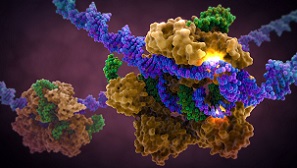Plants have large and complicated genomes. Therefore, until recently, the insertion of foreign DNA was a kind of roulette: where will DNA be modified, will the insertion work, and will there be side effects? But by now, techniques have much improved and totally novel plant breeding techniques have been developed, carrying names like ZFNs, TALENs and CRISPR-Cas (see a glossary at the bottom of this article). These techniques enable us to change DNA with much precision.
Hans Tramper is professor emeritus in Bioprocess Technology at Wageningen University and reflects on the development of his subject in a series of essays. His pieces were published so far on 18 June, 30 June, 11 July, 22 July, 19 August , 10 September, 21 September, 30 September, 10 October, 31 October, 8 November and 2 December 2018.

Novel plant breeding techniques
Novel plant breeding techniques (NPBTs) are another major enlargement of the arsenal at the disposal of plant gene technology. These techniques come on top of the major achievements in the ’80s and ’90s, that had brought us the Agrobacterium vector system (see Essay 4 Part 3); and on top of techniques developed early this century like RNA-interference (see Essay 4 Part 4). These novel plant breeding techniques can be used for transgenesis, but mainly aim at cisgenesis, the insertion of genes that originate solely from closely related organisms; and particularly at ‘gene editing’, that changes just one or a few letters of the DNA at a specific location. The innovative aspects of these techniques are that (1) the mutation is very precise, and/or (2) the final products are free from foreign DNA, and/or (3) the genetic material inserted originates from the same species (cisgenesis), and/or (4) only a specific tissue in a plant is being modified. In sum, this will overcome almost all objections voiced by opponents of gene technology. We can even ask ourselves if these procedures amount to genetic modification at all: we just insert genes that originate from the same species, or just change one or a few ‘letters’ in the DNA. In principle, we could arrive at the same results by the classic techniques of crossbreeding and mutation, but only at the expense of much more precision, time and money. If these novel plant breeding techniques would be legally judged not to amount to genetic modification, this could very much speed up their application.
Among these techniques, CRISPR-Cas stands out for its major opportunities. In comparison with ZFNs and TALENs the CRISPR-Cas technology is simple, fast, cheap and applicable with all biological cells. This technique stems from a defence mechanism of bacteria against viral infections – but as far as we can see now, this technique has very broad applications. Its proper functioning has now also been demonstrated in plants, in very diverse species like wheat, rice, tomatoes, soy, tobacco and poplar. Many agricultural crops have genomic duplicates, i.e. several copies of the same gene. CRISPR-Cas enables us to change at once all copies of a particular gene. The three new systems all belong to the so-called site-directed nucleases (SDNs).
SDN technology
Using SDNs, we can now apply precision modification in plants. These techniques will cut the two complementary DNA helixes at a selective location in the genome, and use the DNA repair mechanism of the cell itself to produce changes. In 2017, Julia Hilscher, Hermann Bürstmayr and Eva Stoger wrote an instructive review article on this subject. Simply put, SDN technology boils down to using a DNA cutting enzyme (nuclease) coupled to a messenger molecule (protein or RNA). Then we introduce this couple into the cell of a plant that we want to modify. The messenger molecule identifies the location in the genome that we want to modify, and the nuclease cuts the DNA there. The cell’s own DNA repair mechanism links the two together again, which will produce major or minor changes. Using ZFNs or TALENs is rather troublesome, because we need to produce new messenger proteins for each application. But CRISPR-Cas9 on the other hand (in which the 9 denotes the lactic acid bacterium as the origin of the molecules) is very successful. This is caused by a relatively small messenger RNA that can easily be adapted. Therefore, we can direct the Cas9-nuclease to any desired location in the genome. The system is cheap, fast and applicable over a broad range of organisms, and therefore accessible to smaller laboratories too. For that reason, I here just discuss the CRISPR-Cas systems and refer to the booklet by the Flemish Institute for Biotechnology (VIB) mentioned in Part 4, for the other systems.

Regulatory bodies, in Europe in particular, were taken by surprise by the speed at which this new technology has made a breakthrough. In North America, regulation refers to the product, whereas in Europe it refers to the process by which the product has been made. Because most products of novel plant breeding techniques do not differ from varieties bred by classic breeding techniques, North American authorities classify them as non-GMOs. But in Europe they have been classified as GMOs by the European Court of Justice in its decision of July 25, 2018 (see Essay 4 Part 4). That implies a lengthy and costly admission procedure, that only leaves the door open to the three largest breeding companies. Its consequence is that smaller companies like for instance Cibus will hardly have any prospects in Europe. Cibus profiles itself as a precision plant breeding company. It offered its first commercial product, herbicide tolerant rapeseed for approval in Brussels in 2017. This crop, SU CanolaTM, is a non-transgenic sulfonylurea-herbicide tolerant rapeseed that would offer a world-wide alternative to Monsanto’s (now Bayer’s) glyphosate resistant varieties. We need the alternative because it would make a little dent into the unwanted monopolistic position of the three major multinational companies. The new variety has prospects, because glyphosate meets with mounting criticism. Very unfortunate, this decision of the European Court of Justice. It leaves virtually no opportunity for Cibus in Europe. Remarkably enough this company has branches in San Diego and St. Paul in the US, Winnipeg in Canada and … the village of Kapelle in Zealand, the Netherlands.
CRISPR-Cas9
Recently (October 2018) the easy-reading booklet Modifying DNA – copy and paste with CRISPR-Cas9 was published (in Dutch), by Kristel Kleijer, a neurobiologist who writes for the New Scientist, among others. The booklet mainly treats applications in the field of biomedicine, but it also contains the story on the naming of CRISPR that I would like to communicate briefly. In 1987, the Japanese researcher Yoshizumi Ishino accidentally discovered a remarkable piece of DNA when cloning a bacterial cell. Normally, the DNA code is irregular, but he then saw a short identical letter combination that repeated itself several times, being interspaced with unstructured pieces of equal length. He did not understand its function, but he devoted six sentences to this phenomenon in one of his publications, as this uncommon structure had not been described before. In 2005, French and Spanish researchers suggested that this was a bacterial defence mechanism against viruses (see next paragraph). In 2002, the Dutch microbiologist Ruud Jansen named the system Clustered Regularly Interspaced Short Palindromic Repeats. Not a very popular name, but exactly what it was all about: in the piece of DNA in question we find Clustered, Regularly Interspaced, Short and easily recognizable pieces, recognizable because they are Palindromic and Repeat themselves. Illuminating, but we still prefer the acronym CRISPR.

In this connection, we need to mention another Dutch microbiologist, John van der Oost. He conducts ground-breaking research in the field of CRISPR and was awarded the Spinoza Prize for it in September 2018, € 2.5 million, the highest Dutch scientific award. In 2008, he published how the repeating DNA pieces protect bacteria against viruses, in association with nucleases, the Cas enzymes. We can look upon CRISPR as a database with small DNA pieces in between the palindromic bits. These intermediate pieces contain information on all bacterial viruses (bacteriophages) that have entered into cell in the course of its existence. In the neighbourhood of the CRISPR piece we find nuclease genes associated with it, the so-called Cas genes, hence the name CRISPR-Cas system.
Quick and simple gene repairs
Science journalist Rik Nijland wrote the informative long-read Quick and simple gene repairs in the December 2017 issue of Wageningen World. Recently he also published an interesting interview with John van der Oost in the November 2018 issue of the Dutch chemical magazine [C2W], at the occasion of the Spinoza Prize. I published the column Mistr CRISPR about John in the October 2016 issue of [C2W]; an expanded version of this article appeared a couple of months later on this website (CRISPR-Cas: a prize winning technology?). John van der Oost and his team have done a lot of work on the development of the CRISPR-Cas technology, please check my 2016 article for more details. He and his team elucidated important principles of the CRISPR mechanism, like the purposeful adaptation of the specificity by re-design/reprogramming of the antivirus pieces, and the transplant of the system to other organisms. This has brought to light the basic principles of editing genomes with CRISPR, and others have eagerly made use of this knowledge.
The names of Jennifer Doudna and Emmanuelle Charpentier are inextricably bound up with the CRISPR-Cas9 system, the species that stems from lactic acid bacteria. They published its characterization in 2012, and shortly afterwards it became clear that Cas9 will enable easy, cheap and simple turning genes on and off, and even the insertion of new genes. This cannot just be done in prokaryotes (bacteria and archaea) but also in eukaryotes (organisms with a cell nucleus). Doudna collected quite a number of prizes already for her findings, among them the prestigious Heineken Prize on September 29, 2016. The junior version was then awarded to Edze Westra, a former PhD student to the Van der Oost group. A form of recognition of the ground-breaking CRISPR work of this team. Doudna and Charpentier are among the people often mentioned as candidates for the Nobel Prize, but so far they were not awarded it. According to former professor Piet Borst they quarrel too much about patents with Feng Zhang and his group, who were the first to show that CRISPR-Cas is effective in mammals too. They don’t like trouble over there in Stockholm.
Among the novel plant breeding technologies, the CRISPR-Cas9 technology has certainly made its way, even though just being six years old. Its results are convincing and the developments are astonishingly fast. Therefore, I would like to finish this part by mentioning an example that has attracted much media attention, for instance as recent as November 10, 2018, by Sander Voormolen in the science supplement of the Dutch newspaper NRC/Handelsblad. Why again then, by me? Because I do not wish so much to draw attention again at the mushroom that colours slowly, one of the first achievements of the CRISPR-Cas9 technology. No, it is particularly because of the location where that mushroom has been developed, i.e. Purdue University. Exactly the university where I entered the field of biotechnology in 1973 (see Essay 1). Through a small operation using CRISPR-Cas, the researchers disabled the gene that causes colouring. The American agricultural department (USDA) characterized this ‘slightly modified’ mushroom as non-GMO, leaving the door open for quick implementation.
Glossary
NPBTs: novel plant breeding techniques
ZFNs: zinc finger nucleases
TALENs: transcription activator-like effector nucleases
CRISPR: clustered regulatory interspaced short palindromic repeats (RNA-guided DNA endonucleases)
Cas: CRISPR associated
SDN: site-directed nucleases
Interesting? Then also read:
Why cannot organic farmers benefit from New Breeding Techniques?
CRISPR-Cas: prize winning technology?
Can we engineer life? Transition is unavoidable
